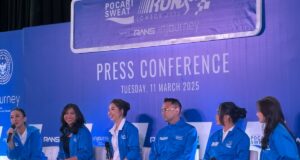Monday, 16 January 2023, Indonesia Hidden Heritage Creative Hub (IHHCH) with the Public Service Agency Transition Team (BLU) The National Museum held a meeting to exchange ideas in an effort to increase tourist visits to historic museums. The meeting which took place at the National Museum was attended by a team from IHHCH and the BLU Transition Team, Mother Irmina Maria Silas. Although this meeting is quite short, but both parties show a common mission to transform the museum into a public creative space.
IHHCH itself has a main focus on turning heritage and historic tourist attractions into a public creative space that is packaged in an attractive form.. This tourist spot can be a museum, buildings or other historical sites. With the concept of public creative space, It is also expected to be able to provide benefits for the local area and promote the museum as a heritage tourism product in urban areas.
IHHCH Executive Director, Nofa Farida Lestari delivered, that currently IHHCH is actively collaborating with the Jakarta Maritime Museum. This collaboration aims to promote the Museum through various collections of Indonesian maritime traditions, and increasing tourist visits to museums. This promotional activity was carried out by IHHCH by utilizing the location of the museum as venue organize creative programs that can be attended by the general public, especially children and adolescents. By holding this creative program, expected to provide awareness to the general public about the museum, and increasing visits to museums. other than that, program Capacity Building manager Visitor service-oriented museums are expected to increase visits.
Capacity Building and Management Challenges
Capacity Building carried out with the aim of increasing the ability of museum managers in promoting product knowledge from the museum itself. As a benchmark, collaboration with various museums abroad is also very much needed, especially for countries that have succeeded in turning their historical museums into recreational destinations for local and international tourists.
The training program is designed to address the challenges and problems faced in an effort to increase tourist visits to museums. The problems faced by these museums, including visitor data collection that has not been systematic, limited budget for museum programs and campaigns, limited number of museum human resources, Human Resources Skills and Knowledge are still limited, lack product knowledge from the museum manager, and the use of technology that has not been maximized.
Therefore, this is a joint homework for the museum, related institutions, and local authorities to address these issues. By improving the quality of human resources and financing, then the Museum can present a more effective management and marketing strategy.
Museum as a Public Service Agency
 The National Museum which is also commonly called the Elephant Museum, is one of the museums that store stories of Indonesian history. This museum stores approx 190.000 objects of historical value consisting of 7 The collection type is Prehistoric, Archeology of the Classical or Hindu-Buddhist period, Numismatics and Heraldry, Ceramics, Ethnography, George, and History. This building has two buildings, namely Building A which is used for showrooms and Immersive rides. And Building B or Building Arca, can be used for office, conference room, laboratory, temporary exhibition space, commercial area and library. At the date of 22 March 2021, The National Museum has also been designated as a Central Government agency with the Public Service Agency Financial Management Pattern (PPK-BLU) under the auspices of the Ministry of Education, Culture, Research and Technology.
The National Museum which is also commonly called the Elephant Museum, is one of the museums that store stories of Indonesian history. This museum stores approx 190.000 objects of historical value consisting of 7 The collection type is Prehistoric, Archeology of the Classical or Hindu-Buddhist period, Numismatics and Heraldry, Ceramics, Ethnography, George, and History. This building has two buildings, namely Building A which is used for showrooms and Immersive rides. And Building B or Building Arca, can be used for office, conference room, laboratory, temporary exhibition space, commercial area and library. At the date of 22 March 2021, The National Museum has also been designated as a Central Government agency with the Public Service Agency Financial Management Pattern (PPK-BLU) under the auspices of the Ministry of Education, Culture, Research and Technology.
According to Irmina's mother, Museum visitors are currently estimated to still be dominated by approx 90% by school students who do field trip, while only 10% come from tourists. This is a record for public authorities and building managers to encourage tourists to want to visit historical museums. Return, this must be accompanied by an attractive museum packaging.
BLU itself is an agency within the government that was formed to provide services to the public in the form of supplying goods and/or services that are sold without prioritizing profit., but in carrying out its activities must be based on the principles of efficiency and productivity. Making the museum a BLU means that the museum works independently or self financing, which is also supported by human resources that must be prepared carefully. The museum is also expected to be able to provide interesting and quality programs whose benefits can be felt by the community, especially Millennials and Gen Z, which is a potential target to crowd the museum. With good education for museum human resources, as well as adapting and involving technological developments, of course this will improve the performance of the museum, while at the same time changing the stigma of a museum that seems ancient.
Development of the museum in terms of buildings, exhibition and program, become an important thing that will increase tourist visits and contribute to increasing regional income. The location around the museum can also be developed into a business space for local MSMEs so that it has an impact on the economic welfare of the community.
Media and Community Officer
Syafa Khalisha Ifadha
email: indonesiahiddenheritage@gmail.com
Sky Tower Lt 12 Suite Infiniti Office 1205
Jl MH Thamrin No 9 Central Jakarta 10340













